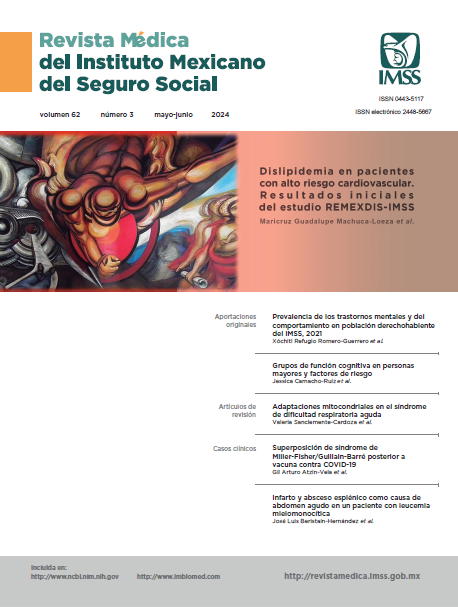Rare diseases in a medical genetics service of population with social security
Main Article Content
Keywords
Prevalence, Orphan Drug, Rare Diseases
Abstract
Background: Rare diseases (RD) are those that have a low prevalence in the population; ≈80% have a genetic origin, and to diagnose them it takes from 5 to 10 years, and they require evaluations from ≈10 specialists. There is no international consensus on the definition and number of RDs, which affects the availability of resources for their diagnosis, treatment, and research.
Objective: To determine the prevalence of RDs in the Medical Genetics Service of a regional general hospital belonging to the Mexican Institute for Social Security (IMSS), in Puebla, Mexico.
Material and methods: The patients’ records who were evaluated by the above-mentioned service from January 2019 to June 2022 were reviewed. Those patients with a diagnosis of a RD were identified, and the prevalence was obtained by using the formula: total number of cases of the disease/number of people in the population at that moment in time.
Results: A total of 798 medical records were reviewed and a prevalence of RDs of 27% was obtained. Those diseases with a prevalence of 1 case per 2000 inhabitants were considered, being 118 different RD. Considering only the 20 rare diseases registered in Mexico in 2022, 11 of these were detected, distributed in 35 patients, with an estimated prevalence of 4.3%.
Conclusion: The prevalence of RDs differs according to the criteria implemented. In Mexico, several diseases that fall within the definition of a RD based on their prevalence were not considered as such until 2022, so the recent recognition of rare diseases included by the World Health Organization will benefit affected patients.
References
Carbajal-Rodríguez L. Enfermedades raras. Revista Mexicana de Pediatría. 2015;82(6):207-10.
Reglamento Interior de la Comisión para el Análisis, Evaluación, Registro y Seguimiento de las Enfermedades Raras. México: Diario Oficial de la Federación; 2017. pp. 1-6.
Carbajal Rodríguez L, Navarrete Martínez JI. Enfermedades raras. Acta Pediatr Mex. 2015;36:369-73.
Mejía Vázquez R, Salgado Schoelly H, Delgado Cruz FT. Medicamentos huérfanos y enfermedades raras. Ciudad de México: Secretaría de Salud de la ciudad de México; 2020. Disponible en: https://salud.cdmx.gob.mx/storage/app/media/2018-2024/medicamentos/boletines2020/Boletin1feb2020.pdf.
Consejo de Salubridad General. Lista actualizada de las enfermedades que se han determinado como raras en México 2018. México: Consejo de Salubridad General; 14 de junio de 2018. p: 12. Disponible en: http://www.csg.gob.mx/descargas/pdf/priorizacion/enfermedades-raras/Listado/Lista_Enfermedades_Raras_2018.pdf.
Consejo de Salubridad General. Amplía Consejo de Salubridad General lista de enfermedades raras. México: CSG; mayo de 2023. Disponible en: http://csg.gob.mx/descargas/pdf/comunicados/CSG_Comunicado_N._2_26may23.pdf.
Consejo de Salubridad General. Acuerdo por el que se reconocen las enfermedades raras incorporadas en la Clasificación Internacional de Enfermedades emitida por la Organización Mundial de la Salud. México: Diario Oficial de la Federación; 29 de junio de 2023. Disponible en: https://dof.gob.mx/nota_detalle.php?codigo=5693770&fecha=29/06/2023#gsc.tab=0.
Nguengang Wakap S, Lambert DM, Olry A, et al. Estimating cumulative point prevalence of rare diseases: analysis of the Orphanet database. European Journal of Human Genetics. 2020;28(2):165-73.
Haendel M, Vasilevsky N, Unni D, et al. How many rare diseases are there? Nat Rev Drug Discov. 2020;19(2):77-8.
Tröster TS, von Wyl V, Beeler PE, et al. Frequency-based rare diagnoses as a novel and accessible approach for studying rare diseases in large datasets: a cross-sectional study. BMC Med Res Methodol. 2023;23(1):143.
Ferreira CR. The burden of rare diseases. Am J Med Genet A. 2019;179(6):885-92.
Lee TSJ, Chopra M, Kim RH, et al. Incidence and prevalence of neurofibromatosis type 1 and 2: a systematic review and meta-analysis. Orphanet J Rare Dis. 2023;18(1):292. Disponible en: https://ojrd.biomedcentral.com/articles/10.1186/s13023-023-02911-2.
Hageman IC, van Rooij IALM, de Blaauw I, et al. A systematic overview of rare disease patient registries: challenges in design, quality management, and maintenance. Orphanet J Rare Dis. 2023;18(1):106. Disponible en: https://ojrd.biomedcentral.com/articles/10.1186/s13023-023-02719-0.
Mazzucato M, Pozza LVD, Facchin P, et al. ORPHAcodes use for the coding of rare diseases: comparison of the accuracy and cross country comparability. Orphanet J Rare Dis. 2023;18(1):267. Disponible en: https://ojrd.biomedcentral.com/articles/10.1186/s13023-023-02864-6.
Willmen T, Willmen L, Pankow A, et al. Rare diseases: why is a rapid referral to an expert center so important? BMC Health Serv Res. 2023;23(1):904. Disponible en: https://bmchealthservres.biomedcentral.com/articles/10.1186/s12913-023-09886-7.
Palmer E, Millis N, Farrar M, et al. Rare diseases New approaches to diagnosis and care. Med Today. 2023;24(1-2):69-75.
Faviez C, Chen X, Garcelon N, et al. Diagnosis support systems for rare diseases: a scoping review. Orphanet J Rare Dis. 2020;15(1):94. Disponible en: https://ojrd.biomedcentral.com/articles/10.1186/s13023-020-01374-z.
Marimpietri D, Zuccari G. Development of Medicines for Rare Pediatric Diseases. Pharmaceuticals. 2023;16(4):513. Disponible en: https://www.mdpi.com/1424-8247/16/4/513.
Grasemann C, Höppner J, Burgard P, et al. Transition for adolescents with a rare disease: results of a nationwide German project. Orphanet J Rare Dis. 2023;18(1):93. Disponible en: https://ojrd.biomedcentral.com/articles/10.1186/s13023-023-02698-2.
Matthews L, Chin V, Taliangis M, et al. Childhood rare diseases and the UN convention on the rights of the child. Orphanet J Rare Dis. 2021;16(1):523. Disponible en: https://ojrd.biomedcentral.com/articles/10.1186/s13023-021-02153-0.
Velvin G, Dammann B, Haagensen T, et al. Work participation in adults with rare genetic diseases - a scoping review. BMC Public Health. 2023;23(1):910. Disponible en: https://bmcpublichealth.biomedcentral.com/articles/10.1186/s12889-023-15654-3.
Larizza L, Cubellis MV. Rare Diseases: Implementation of Molecular Diagnosis, Pathogenesis Insights and Precision Medicine Treatment. Int J Mol Sci. 2023;24(10):9064. Disponible en: https://www.mdpi.com/1422-0067/24/10/9064.
Wright CF, Fitzpatrick DR, Firth H V. Paediatric genomics: diagnosing rare disease in children. Nat Rev Genet. 2018;19(5):253-68.
Rivera-Silva G, Treviño-de la Fuente F, Treviño-Alanis MG. Enfermedades raras en México. Rev Med Inst Mex Seguro Soc. 2018;56(3):214-5. Disponible en: https://www.redalyc.org/journal/4577/457757174002/
Jurca-Simina IE, Chirita-Emandi A, Andreescu N, et al. Burden Of Rare Genetic Diseases-Experience Of Timis Regional Centre Of Medical Genetics, Romania. Jurnalul Pediatrului-Year XXII. 2019;22:85-6.
Tumiene B, Peters H, Melegh B, et al. Rare disease education in Europe and beyond: time to act. Orphanet J Rare Dis. 2022;17(1):441. Disponible en: https://ojrd.biomedcentral.com/articles/10.1186/s13023-022-02527-y.
Tsitsani P, Katsaras G, Soteriades ES. Barriers to and Facilitators of Providing Care for Adolescents Suffering from Rare Diseases: A Mixed Systematic Review. Pediatr Rep. 2023;15(3):462-82. Disponible en: https://www.mdpi.com/2036-7503/15/3/43


